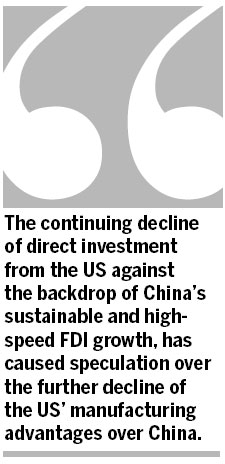Despite its status as the world's largest source of FDI, the US' direct investment in China keeps declining
China received a total of $48.03 billion in foreign direct investment (FDI) from January to May, an increase of 23.4 percent year-on-year. However, the investment from the United States was only $1.28 billion during the same period, a decline of 24.1 percent on the previous year.
The continuing decline of direct investment from the US, the world's largest FDI source, against the backdrop of China's sustainable and high-speed FDI growth, has caused speculation over the further decline of the US' manufacturing advantages over China, which replaced the US as the world's largest manufacturer in 2010.
Currently, manufacturing volumes comprise 10 percent of the US' economic output. However, such a comparatively small manufacturing volume does not inevitably mean that the US is losing the upper hand to other countries in terms of manufacturing.

The reason for the US' long-standing status as the world's largest source of FDI largely lies in the absolute dominance of the dollar in the international monetary system and its own industrial advantages in the world market. A typical case is the large-scale investment the US realized in West European countries in the 1960s and 1970s by means of its unchallenged computer, auto and telecommunications advantages.
The US' FDI received a strong boost in the 1990s with the accelerated pace of globalization and its FDI volumes reached $355.2 billion in 2009 - despite the impact of the global financial crisis - only slightly lower than the $350.2 billion in 2007.
Different from many other countries that are usually inclined to transfer their technologically backward industries overseas in the form of FDI, the US has realized its direct overseas investment mainly through capital and shares control. For those industries in which it has lost the competitive edge, the US usually adopts an outsourcing strategy to funnel its overseas investment into the fields where it holds dominant advantages.
Currently, manufacturing FDI accounts for 15.4 percent of the US' total outbound FDI. Considering that manufacturing takes up a comparatively small share in the US' economic output, such a proportion is considerable, demonstrating to some extent that the US' manufacturing advantages have not been weakened.
On the contrary, the US has long held an upper hand over other countries in high-end and upstream manufacturing fields through its strong technological advantages and innovative capabilities. It has particularly enjoyed advantages in electronic information, telecommunications, biomedicine and aerospace, as well as new materials and new energy technologies.
Despite its status as the world's largest source of FDI, the US' direct investment in China is disproportionate, standing at $3 billion for many years. There are two main reasons for this: The first is that China's financial market is still not fully open, which makes it difficult for the US' financial sector, a field in which the US has unparalleled advantages, to enter China. The second is that the US' manufacturing mainly centers on those high-end fields that have high technological demands and thus its outbound manufacturing investment has largely flowed to developed countries.
In the face of employment pressures and its huge trade deficit, the Obama administration has worked out plans to double US exports within five years. A recent report released by the Boston Consulting Group suggests manufacturing in the US is beginning to rally and is expected to rise again soon under the Obama administration's ambitious export strategy.
With the rise of China's labor costs and the appreciation of the yuan, the time for the US to outsource its manufacturing business to China will come to an end, and the US will re-emerge as a new manufacturing power in the coming years, the report said. It further predicted that of commodities sold within the US, its domestically produced goods will take the lead over made-in-China brands by 2015.
Undeniably, the US has overwhelming advantages in manufacturing technology, brand influence and marketing. However, the US still needs time to raise its manufacturing sector after its adoption of the outsourcing strategy for a long period of time. It is unlikely that many big-name US enterprises will rush to restore their outsourced manufacturing to the US, whatever the wishes of the government and ordinary people.
Thus, it is expected that the US will still maintain its current lukewarm FDI momentum in China until the coming of next technological innovations.
Zhang Yi is a researcher with the Institute of Foreign Economy, the National Development and Reform Commission, and Zhang Anyuan is a visiting professor with the University of International Business and Economics.
(China Daily 07/07/2011 page8)